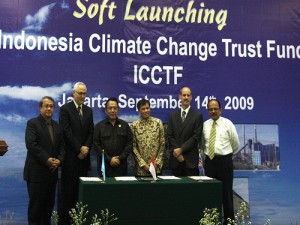Daniel Murdiyarso, a researcher with CIFOR – one of the world’s top forestry and conservation research organizations – estimates that Indonesia stands to gain around USD 15 billion a year from the trading of forest carbon credits, known as Reduced Emissions through avoided Deforestation and Degradation (REDD).
This, of course, is dependent on REDD being incorporated into a post-Kyoto climate treaty in 2012.
Perhaps based on the expectation that USD 15 billion will begin streaming into the country, Indonesia and the UNDP have teamed up to create the Indonesia Climate Change Trust Fund, officially launch Monday, September 13.
While living in Aceh, Sumatra, I was involved in designing a project design document for a REDD pilot project. My hope was that a local level REDD trading scheme could allow the maximum percentage of carbon revenues to arrive directly to forest communities and forest managers for their efforts to reduce illegal logging and palm oil expansion, as well as compensation to cancel industrial logging concessions.
But as REDD policy has matured, it has become clear that Indonesia’s government will have a central role in all REDD trading. Allowing Jakarta to control all REDD payments poises the danger that Indonesia’s forest peoples, whom have a long history of being at best overlooked and at worst brutally oppressed by Indonesia’s central government, will loose out yet again. Just recently, a coalition of Indonesia’s Indigenous peoples expressed serious concern about the threat carbon trading poses to their forests and livelihoods.

The talk of 15 billion dollars for forest conservation projects is an exciting one; forest conservation money is tight in Indonesia, and too often forest managers are stretched too thin and local people overlooked in Indonesia’s top conservation priority forests; in one National Park I visited in West Kalimantan, Taman Nasional Kutai, there were just 4 park rangers on duty at any one time.
But according to the UNDP, climate change funds will be used for: “The energy, forestry, transportation, waste management, agriculture, maritime and fisheries, water resources and health sectors…”
That sounds great, but lets think through the numbers a bit.
Indonesia could potentially gain a total of USD 15 billion per year from REDD, which is about 1.6% of Indonesia’s GDP.
This USD 15 billion will only come if Indonesia eliminates it’s 1.87 million hectares a year of forest destruction from now into perpetuity. Permanently ending Indonesia’s massive oil palm plantations, industrial logging’s clear cutting, illegal logging, road building, and forest encroachment will not be easy, and definitely not cheap.
So possibly, if Indonesia’s notorious corruption doesn’t siphon off too much of the USD 15 billion into private bank accounts, there will be an extra 1.6% in spending available to the government. But if these revenues are split between 9 different sectors, is it reasonable to think that all deforestation will be halted in Indonesia?
It seems that in the rush and excitement of creating a new industry, carbon trading, even the top-level of Indonesia’s government and the UNDP have forgotten that REDD carbon credits must be generated by on-the-ground conservation of forests.
Since hearing about the Climate Change Trust Fund this week, my thoughts have continued to return to an anonymous text message I received a few times while living in Sumatra.: “We, the common people, are poor. The politicians use our forests to get rich, and keep us living with nothing.”
David Gilbert is a Research Fellow at RAN. He has worked in the tropical forests of the Amazon and Indonesia, with a special focus on forest conservation and indigenous rights. He can be reached at davidgilbert@ran.org